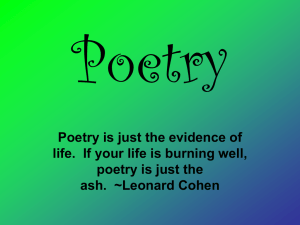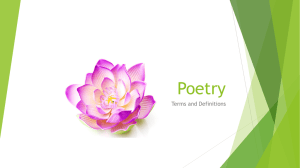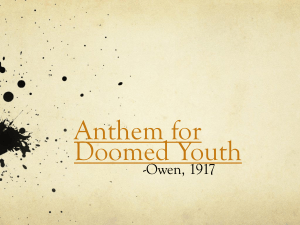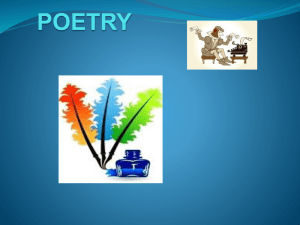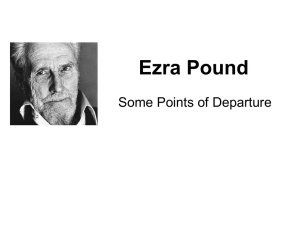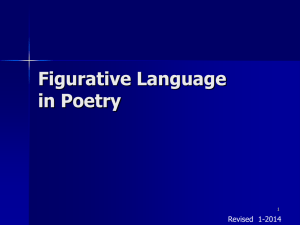Rhythm
advertisement
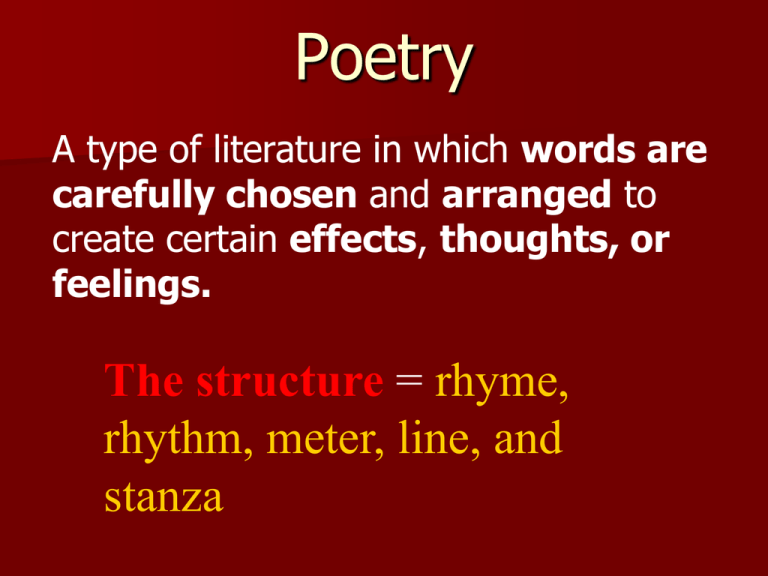
Poetry A type of literature in which words are carefully chosen and arranged to create certain effects, thoughts, or feelings. The structure = rhyme, rhythm, meter, line, and stanza SPEAKER VS POET The voice that “talks” to the reader, similar to the narrator in fiction. The speaker is not necessarily the poet. To understand a poem, you must learn who the speaker is and how he/she feels. If the poem mentions certain experiences that had happened doesn’t mean that it happened to the poet personally. ELEMENTS OF POETRY GRAPHIC ELEMENTS (capitalization, punctuation, line breaks, white spaces) SENSORY DETAILS (5 senses) RHYTHM-Word Choice and Pacing SOUND PATTERNS-(rhyme, onomatopoeia, alliteration, assonance, consonance) FIGURATIVE LANGUAGE Capitalization/Punctuation Is used to show the reader how to read the poem A poem may not have any punctuation; sometimes a comma is left off because a line break signals a PAUSE, and a comma isn’t necessary Monsters under my bed never speak never move but they are there. There could have been a comma after speak, but it’s not necessary. Capitalization/Punctuation Continued Poems may have commas, semi-colons, periods, question marks, and exclamation points In classic poems, the first word in each line is capitalized. Now, when you see more modern poetry, capitalizing the first letter creates an effect (formality, strength, or emphasis); Read the poem again-creates a sense of fright. Monsters under My bed Never speak Never move But they are There. Needs to be consistent Line Breaks Where the line of poetry ceases to end and a new line begins. How the poem is divided. Some poems have a natural rhythm like a song. It’s easy to know where to break the line. The school is closed and dark, and the teachers are at home. The kids are all asleep, but I’m writing this little poem. Sometimes the line breaks where the thought ends, or where the reader or the poet naturally pauses. When summer is departing and fall is arriving, the wind whips through the trees and spooks the cat. Sometimes the line breaks are in unexpected places. A poet can break a line in the middle of a poem to tease you into going to the next line. A thought can go from one verse, or stanza, to another. (enjambment or run-on) Home is where you It depends how you want to place the line break. It will affect the way the poem reads, its meaning, and its appearance! can shrug off your backpack and your worries, sling around your complaints about impossible questions on the science test, and supposedly best… WHITE SPACE Lines are usually short enough that white space appears to the right or left of the poem, or both if the poem is in the center of the page. Text can be anywhere on the page. Words can be separated. The words can look like what they are saying. rain wh te dripped sn wflakes and f lling drop- ped The girls threw the ball down back my and forth neck Indentions is another way to play with white space. In the poem about a walk, the poet might indent as she’s going around a bend. I tiptoed down the path and around the bend to find my sister hiding under the willow tree Indentions can signal opposites or two voices speaking. Indentions can place emphasis on a part of a poem. My shadow copied me as I hopped skipped and boogied. I looked inside and outside but she was nowhere. SENSORY DETAILS CREATES STRONG IMAGES OR MENTAL PICTURES FOR THE READER THESE PICTURES FORMED IN YOUR MIND ARE CALLED IMAGERY USES THE 5 SENSES: SIGHT, SMELL, TOUCH, TASTE, HEARING THE USE OF PERSONIFICATION, SIMILE, AND METAPHOR CAN PAINT A VIVID PICTURE RHYTHM AND REPETITIONWord Choice and Pacing Poets can control the pace, or how quickly you read a poem. Some words are sharp and short. The thorns jab my arm, my leg, my cheek. Other words roll off your tongue and you delay, reading more slowly. The sunlight meandered over to my hammock and filled the afternoon with laziness. Rhythm-The pattern of stressed/unstressed syllables in a line of poetry. It’s the meter (rhythm that’s organized into specific patterns) of the poem. (brings out musical quality of lang., emphasizes ideas, creates mood) A fast rhythm indicates ACTION, EXCITEMENT, TENSION or SUSPENSE. A slow rhythm suggests peacefulness, fullness, harmony, and comfort. In a poem, the rhymes form a pattern called RHYME SCHEME. The letters of the alphabet are used to show the rhyme scheme. Each set of rhyming words is given the same letter. Under my hat is my hair A Under my hair is my head B Under my head is a seven-year beard C And a tie that is yellow and red D …coat E …vest F …bump G …chest F Sound Devices Alliteration-The repetition of consonant sounds at the beginning of words. (Peter Piper picked a peck of pickled peppers.) and it must show an image. Assonance-Repetition of vowel sounds within a line of poetry. power hour mild child Consonance-When words share an ending consonant sound, but their vowels are different live leave crib nab give move Onomatopoeia-When words sound like what they mean chirp, slash, dart, crush, dash, creak Skiing Down the mountain Gliding, sliding Swish, swoosh Almost down Turning right, turning left Really close Swish, swoosh At the bottom. FIGURATIVE LANGUAGE SIMILE METAPHOR PERSONIFICATION SIMILE A simile uses the words like or as to compare two unlike things. I feel public, like a frog. I am as lonely as the last leaf on a tree. METAPHOR A metaphor also compares two unlike things, but do not use the words like or as. She is a thin sparrow. A web of snow engulfed me. PERSONIFICATION Sometimes poets use words that make things and animals seem human. The trees whispered among themselves.


